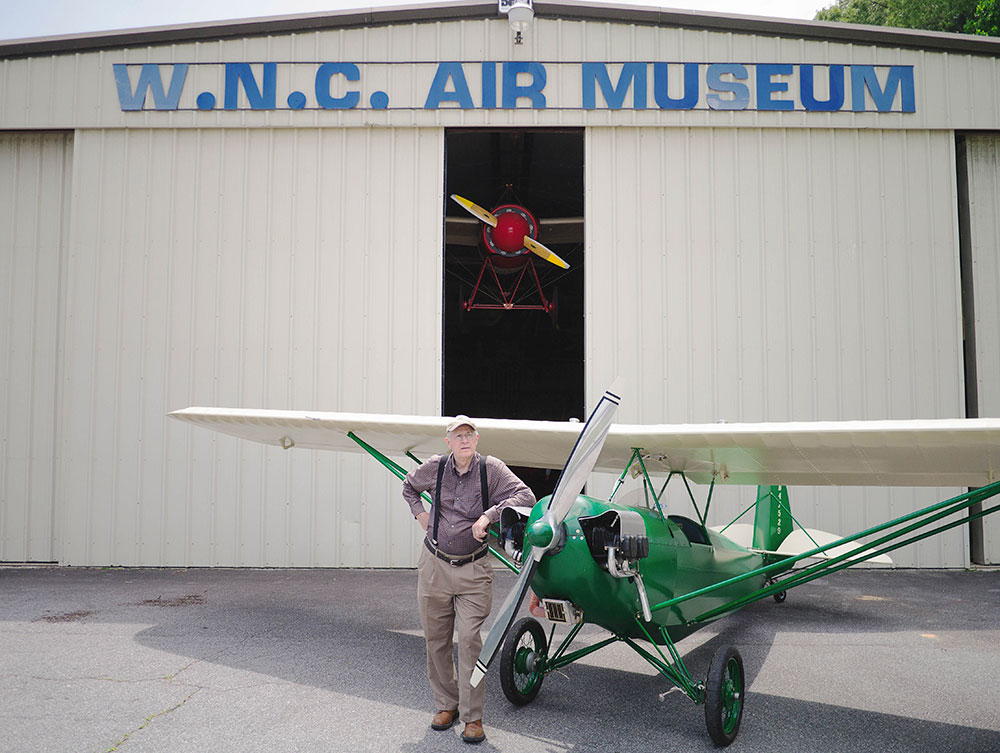
(l-r): WNC Air Museum members Don Brown, Dennis Dunlap, Ken Stubbs, Joe Lilley, Don Buck, and Al Denn still enjoy the high life. Photo by Matt Rose
Down a quiet road bordering Hendersonville Airport’s grass strip sits a nondescript gray hangar. But when the doors roll open, the WNC Air Museum springs to life. Nineteen bright historic aircraft and replicas are poised for takeoff or suspended midair, seemingly ready to zoom out toward the horizon. The warm tones of voices lift and fall as museum members — many of whom have personally resurrected these airplanes — mingle. They duck every now and then to avoid a wing.
Each plane has many stories, and their caretakers are excited to share them. Like the model that Douglas “Wrong Way” Corrigan flew across the Atlantic, or a bomber you might recognize from the movie Dunkirk, or even a replica of the original Wright Flyer. You might see the warm wood paneling of one of the first luxury airplanes or imagine what it would be like to refuel an airplane mid-air by crawling out on the wing.
Then, there are the tales of how each was acquired. Many were donated after a lifetime of care by hobbyists. Or perhaps a widow wanted her husband’s plane to teach others. One, the 1928 Heath Parasol, was discovered above a false ceiling in a barn. Perhaps the original owner worked on it for years, then another owner built a ceiling, and yet another bought the property.

Photo by Matt Rose
Past president Joseph Lilley, the museum’s aircraft broker and web-and-social-media manager, explains, “[We] got a call and the gentleman said, ‘Hey, I just bought a house and there’s an airplane hanging from the rafters. Can you guys come out and look at it and see if it’s something you want?’”
Perhaps most important are the stories of the planes’ restoration and upkeep. Members’ excitement when a new plane arrives is palpable. Rarely, the craft taxies in in tip-top condition. More often it arrives disassembled, with every wooden component in decay.
For those, all the fabric may need to be peeled off and the plane’s wooden skeleton replaced, down the the last fastener. Members jump in on all jobs, from cosmetic fixes to metalwork and engine repair. The museum’s curator, Al Denn, even makes wooden replicas of the WWII-era guns that each would have carried.

Photo by Matt Rose
One of the museum’s most recent projects, the Taylor E-2 Cub, required a comprehensive restoration. Everyone was invited to help. Dennis Dunlap and Ken Stubbs, two of the museum’s founders, have restored six WWII era Stearman bi-planes over the years. Dunlap still flies a 1943 Stearman for museum events. It had been wrecked in Idaho Falls, its wings mangled. “Every piece of it has been touched,” he says.
At first, such planes took them several years to finish, even with members like Stubbs, who is an aircraft mechanic, and who has flown since he was 17, operating a Stearman as a crop duster for his family’s farm. In addition to flying recreationally — once from coast to coast — and taking visitors up for rides at Air Fair, Dunlap uses the Stearman to spread the ashes of the deceased over their most beloved landscapes.
Vice President Jarrod Jarvis remembers growing up in Kitty Hawk, the birthplace of aviation, and hustling to the airport when he heard a plane. “I was the kid on the outside of the fence looking up.”
That’s how he ended up at the Museum. He became a member on his first visit. A builder by trade, he loves that he can put woodworking skills to use as well as parlay his love of aircraft into working as a docent. He notes that he was the youngest member when he joined and has made it a mission to get youth involved.

Photo by Matt Rose
Now, the youngest is 15. And the museum has a growing number of women and is working to recruit more. Denn, a lifetime researcher, says the key is getting involved with the airplanes, perhaps just dusting them or opening the museum to visitors. To him, enthusiasm is much more important than skill. Of course the museum sees its share of excited children, but also invites older kids and young adults to care for planes, serve as a docents, organize books, or even camp out. “Once you’re involved, it gets in your blood,” Denn says.
Jarvis can attest to that. Since that day that he found the museum, he has worked on the planes, met men he calls heroes, given talks on the Wright Brothers, and even knows the thrill of flying in a B-17 bomber, of being under the glass dome at 10,000 feet. And it all started with a chance visit to the museum and the kindness of the members who were there that day.
For details on the Western North Carolina Air Museum, call 828-606-1252 or visit westernnorthcarolinaairmuseum.com.


